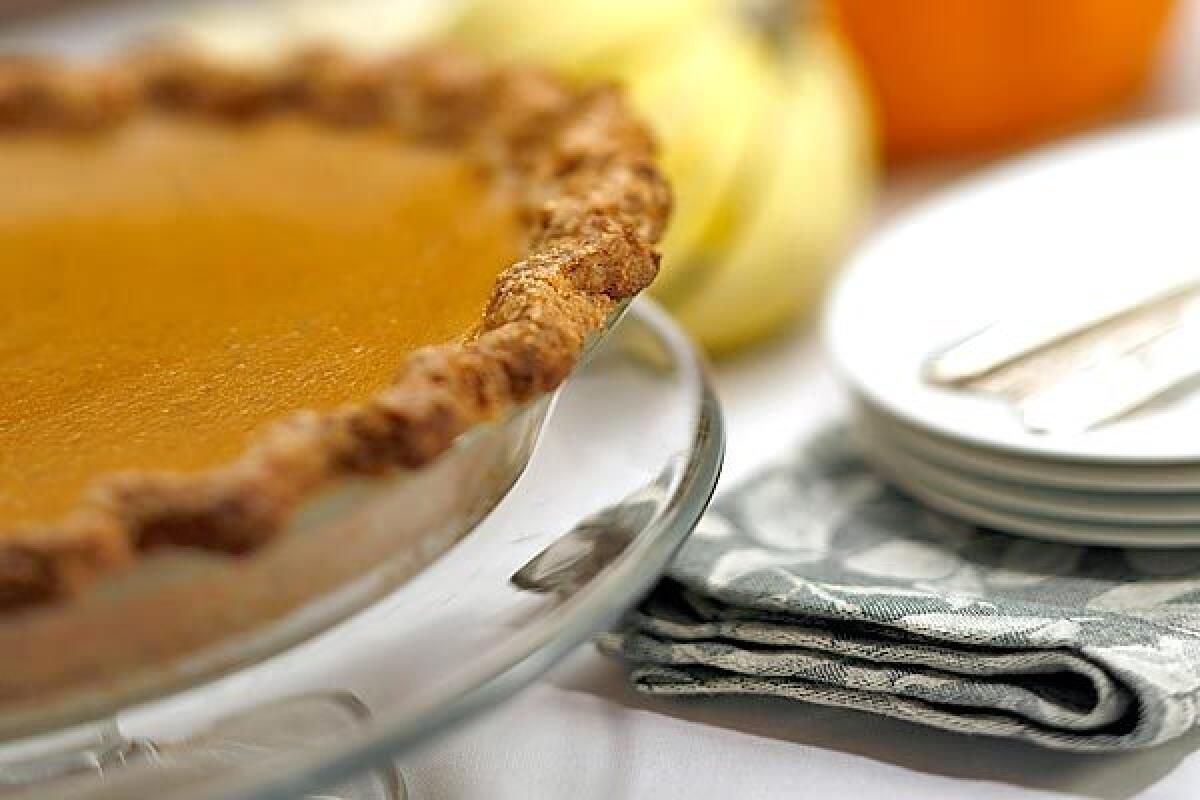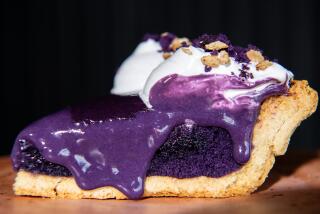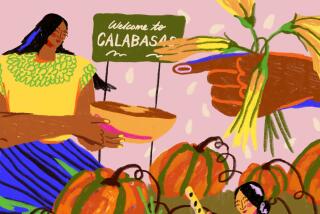Pumpkin passion canât be squashed

For pumpkin lovers, there may be nothing better than a simple slice of a great pie. That rich, velvety custard filling baked atop a flaky, golden crust, a great pumpkin pie is a thing of sheer beauty, a perfect way to show off the very best the squash has to offer.
Then, of course, there are the leaden hockey pucks that pass for pies at way too many a holiday gathering. Thick, dense filling -- either cloyingly sweet and spiced to the hilt, or dismally bland -- baked atop a crust thatâs about as easy to gnaw as a Frisbee and just as flavorless.
Theyâre enough to make any pumpkin lover cry.
Iâve been a fan of the pumpkin for as long as I can remember. For me, growing up in Southern California, seasons werenât marked so much by changes in the weather as by events. To my young mind, âfallâ didnât officially start until the family packed into the station wagon to make the annual trip to the local pumpkin patch. Once there, it seemingly took forever for my siblings and me to scamper about, hunting for the perfect pumpkins to carve.
The leftover seeds were probably the first thing I ever cooked by myself. One year, I carefully picked and cleaned the seeds from the carving leftovers and toasted them on the stove top with a little butter and seasoning, amazed that they could actually be transformed into something edible and tasty.
That experience sparked an interest in cooking. Soon I was hanging out in the kitchen, studying my motherâs every move as she, an amazing home baker, would prepare her famous pumpkin pies for the holidays. When I finally began cooking professionally, I found myself using pumpkin everywhere I could, adding the squash to breads, cakes and soups, and using the seeds to lend crunch to stuffings and salads.
Inevitably, my passion for cooking intersected with my love of gardening, and a few years ago I started a small vegetable garden in my backyard. The first year, I planted -- or rather, over-planted -- four (yes, four) kinds of pumpkins.
They were all standard varieties found at a local hardware store: a couple jack-o-lantern types, a Sugar Pie and a cute miniature. The garden was orderly and manageable until the summer heat hit and those pumpkin vines started to grow literally a foot a day. Before long, the entire garden was consumed by vines. Secretly, I didnât mind -- pumpkins were growing everywhere! Iâd excavate the garden every few days, counting squash and checking to make sure everything was happy.
Come fall, I harvested my own pumpkin patch. Iâd actually grown several rather decent-looking pumpkins. Most I reserved for holiday decoration; the rest I set aside in the kitchen, eager to test in recipes.
But that first batch of pumpkins turned out to be a disaster. The Sugar Pies were plain, almost flavorless to me. The jack-o-lanterns were even worse -- overly starchy and fibrous.
The next year, I decided to try heirlooms. I pored through seed catalogs like others pore through the latest fashion magazines. There were so many to choose from! I finally decided on two: Galeuse dâEysines and Long Island Cheese squash.
The results were a bit better. Visually striking -- soft peach skin covered with peanut-like warts -- the Galeuse dâEysines had a nice mellow flavor and lent itself well to both sweet and savory dishes. The Long Island Cheese was beautiful, but fibrous with hollow flavor.
This year, I thought Iâd take a break from pumpkins and winter squash, and tried my hand at growing summer squash. But with fall here, all I can think about are pumpkins. And I wanted to sample what I could find before I settled on seeds for next year.
Itâs amazing how many different squash are readily available at farmers markets -- and even grocery stores -- these days. It seems that just a few years ago, you could find a couple of pumpkins, and maybe a half-dozen other squash and that was about it. Nowadays, there are MusquĂŠe de Provence pumpkins, Australian Blues and Giant Hubbards along with the more usual Sweet Dumpling, Turban and Kabocha squash. The list goes on and on.
I decided to search out what squash I could (this was no scientific test, I simply wanted to see what was available) and roast and taste them so I could better judge them for taste and texture. With little effort, I collected close to 20 types.
I roasted the squash, plain, until tender, then sampled them, judging them for flavor (sweet to savory, herbal or other notes) and texture (smooth to fibrous). Tasting them side by side made it easy to appreciate the wide spectrum of flavors and the subtle differences between individual squash.
There were several favorites. I loved the Winter Luxury pumpkin for its intense sweet flavor and smooth orange flesh. I also loved the complex, savory notes of the Chirimen, the creaminess of a âFairyâ squash and the delicate sweet-savory balance of a Blue Jarrahdale. We also enjoyed the intense, sweet flavors of the more easily found butternut and Sweet Dumpling squash.
And donât turn up your nose at canned pumpkin, either. Canned foods often get a bad rap, but canned pumpkin can work well in many recipes that call for a purĂŠe. Granted, canned pumpkin canât compete with the depth and complexity of flavors of a carefully grown and ripened heirloom squash. But it is readily available and consistent in flavor, texture and moisture content, whereas actual squash varies.
When you find good-quality squash, making your own purĂŠe is easy. Halve it, scoop out the fibrous middle and seeds, and roast it on a baking sheet until tender and a knife pierces it easily, about an hour or so depending on the variety.
When I have great squash, my thoughts naturally turn to great pie, one that celebrates the flavor of the squash itself -- slightly sweet, rich and almost a little earthy. Sweeten the pie filling, but donât overdo it. Support the flavors with just enough spice to add a little character.
The crust should be a supporting player, but it certainly doesnât have to be a blank slate. Great pie crusts are flaky and have classically been made with butter, shortening, lard or a combination. Instead of lard, I prefer to flavor my crusts with a little bacon fat. Bacon especially goes well with pumpkin, lending just a little extra richness. I also use a little bourbon -- the alcohol helps to make for a flaky crust, and it complements both the bacon and pumpkin flavors.
Bake one of these for your next holiday gathering, and you can be certain you wonât have to face another orange hockey puck. And who knows? You might just convert another pumpkin lover.
More to Read
Eat your way across L.A.
Get our weekly Tasting Notes newsletter for reviews, news and more.
You may occasionally receive promotional content from the Los Angeles Times.











